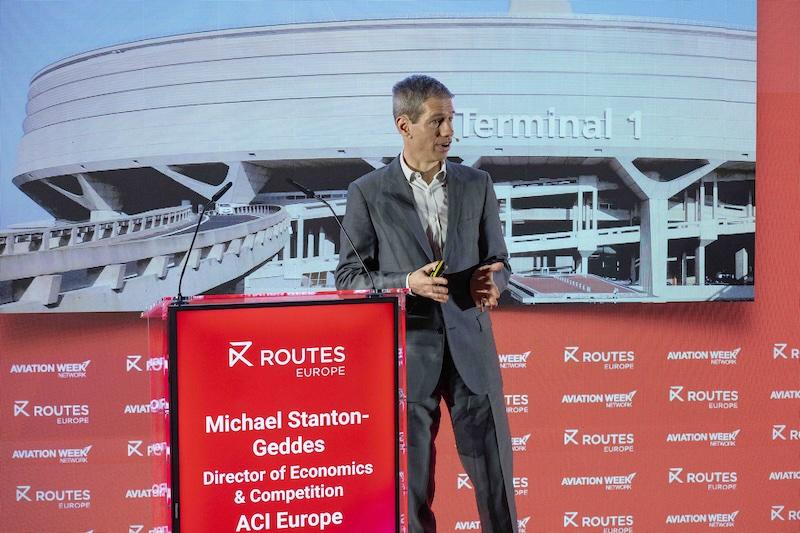
Michael Stanton-Geddes, director of economics and competition at ACI Europe, on stage at Routes Europe 2025 in Seville.
SEVILLE, Spain—Europe’s airports have collectively surpassed pre-pandemic passenger traffic levels, but the recovery remains uneven, and future growth may depend on political will and supportive policies, according to Michael Stanton-Geddes, director of economics and competition at ACI Europe.
Speaking at Routes Europe 2025 in Seville, Spain, Stanton-Geddes confirmed that European airports handled 2.5 billion passengers in 2024, marking the first time annual traffic exceeded 2019 levels. “We hit a high watermark for airport passenger traffic,” he said. “But only half the countries have actually exceeded their pre-pandemic volume.”
Tourism-oriented countries such as Spain, Portugal, Italy, Greece and Poland have seen strong growth. “We see some common characteristics,” Stanton-Geddes said, pointing to “leisure markets and emerging aviation markets,” like Albania, as out-performers.
By contrast, several airports in Scandinavian countries and France continue to struggle. Many airports in these regions remain as much as 40% below their pre-COVID numbers. “The countries that are not growing, nearly all of them have very high sectoral taxes charging aviation,” Stanton-Geddes said.
He also pointed to structural challenges facing smaller airports. Regional jets now account for less than 5% of European departures, creating a shortfall in connectivity for thinner routes. “That presents a significant hurdle for smaller airports,” he added.
Stanton-Geddes outlined several major shifts in the market since 2019. Seasonal peaks in July and August have returned, while airfares are up more than 30%. “Airfares remain very high relative to what they were in the past,” he said. “This is sustained by low-cost carriers and international carriers, who are using their pricing power even as they put more capacity into the market.”
Longer-haul travel is on the rise, with growing demand for connections outside the continent. “Compared to 2019, inter-European growth is around 4%, while growth outside of Europe is up by nearly 18%,” he said, citing Africa and Asia-Pacific as standout markets.
Despite global uncertainties—from geopolitical tensions to weakening consumer confidence—Stanton-Geddes struck a cautiously optimistic tone. “Consumers are protecting their travel budget,” he said, noting the growing appeal of secondary and emerging destinations. “Airfares are stabilizing ... we’re not seeing increases, and we may [soon] see carriers responding with lower airfares.”
However, he warned that the industry’s path to decarbonization could be undermined by current tax regimes. “Governments are punishing aviation through taxes, which are starving the industry of the capital to reinvest into decarbonization,” he said. “We need governments to work with the air transport industry and not against it, because aviation is an enabler of growth.”





